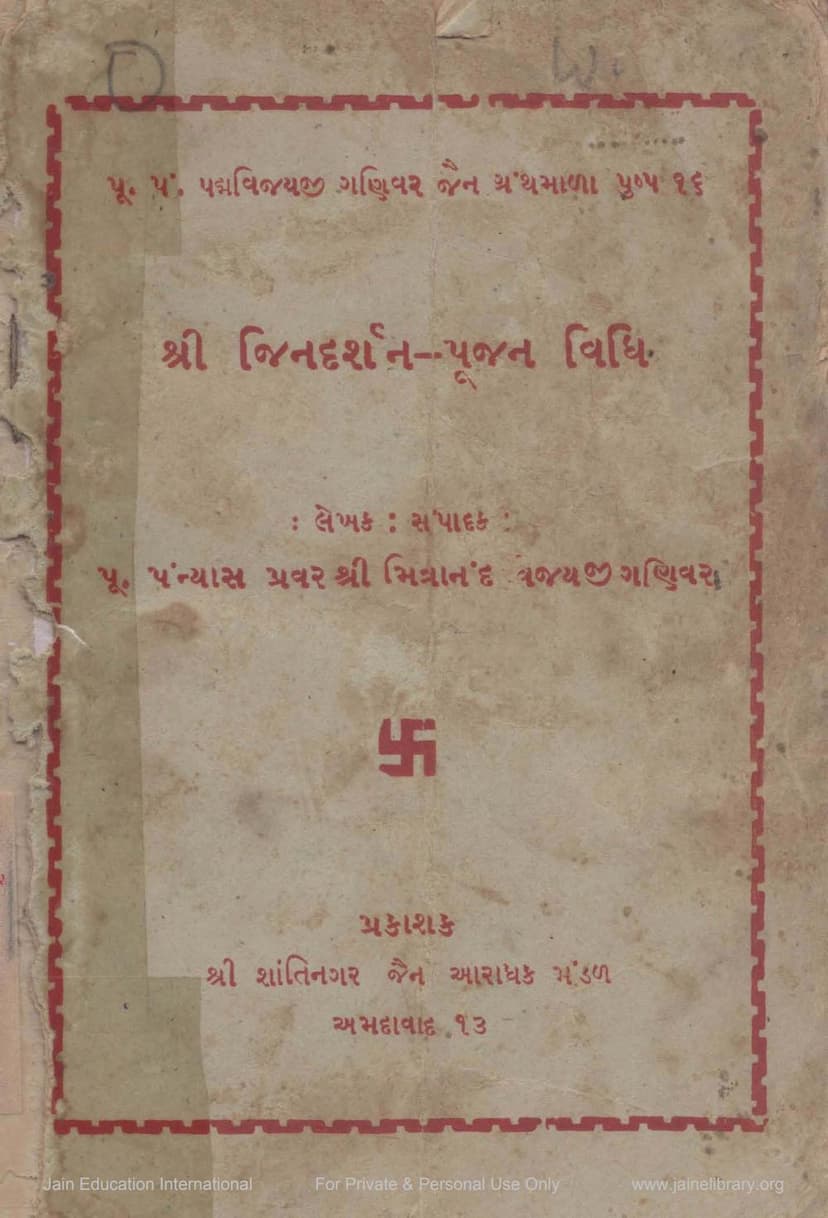Jina Darshan Poojan Vidhi
Added to library: September 2, 2025

Summary
This document, "Shri Jin Darshan Poojan Vidhi" authored by Muni Mitranand Vijay, published by Shantinagar Jain Aradhak Mandal Ahmedabad, is a comprehensive guide to Jain rituals and practices, particularly focusing on the significance and proper execution of devotion to the Jina. The book is presented as part of the "Shri Jina Deshan Poojan Vidhi" series, compiled and edited by the esteemed Muni Mitranand Vijay.
The core message of the book emphasizes the vital importance of vidhi (proper procedure or method) in religious activities. The author uses analogies from daily life, like cooking or accounting, to illustrate that even minor deviations from the correct method can lead to undesirable outcomes. This principle is applied to religious practices, arguing that Dharma and its rituals are like potent medicines, and their efficacy depends on precise adherence to the prescribed methods. The text states that performing rituals correctly, with devotion and respect for the teachings of the Arhats, leads to the destruction of karmas, fosters interest in Dharma, brings contentment, purifies the soul, and instills equanimity.
The book is structured into several key sections:
1. Dharma Jagarika (Spiritual Awakening): This section emphasizes waking up early, ideally during Brahmamuhurta (the auspicious time before sunrise), as a crucial first step towards spiritual engagement. Waking up late is seen as detrimental to both worldly and spiritual progress. The text stresses the importance of immediately remembering the Navkar Mahamantra upon waking, likening the mind to a fresh clay pot that takes the impression of the first thing it receives. It critiques the modern lifestyle of some Jain youth who wake late and are preoccupied with worldly matters, urging a return to the fundamental practice of reciting the Navkar mantra from the moment of waking. The significance of reciting 108 Navkar mantras daily is explained, linking it to the 108 qualities of the Pancha Parmeshthi and the need to counteract the 108 ways in which one might commit sins.
2. Prabhu Darshan Vidhi aur Rahasya (Procedure and Mystery of Lord's Darshan): This section details the significance of seeing the idol of the Tirthankar Parmatma, describing it as the path to ultimate well-being and auspiciousness. Darshan is said to destroy sins, lead to heavenly realms, and ultimately to moksha (liberation). It encourages devotees to deeply contemplate the lives and virtues of the Tirthankaras through their idols. The text draws parallels with jewelers meticulously examining precious stones to understand their true value, advocating for the same focused and attentive darshan of the divine. It highlights that observing great souls reveals one's own flaws and inspires the elimination of negative tendencies. The section also outlines the spiritual rewards associated with various actions performed during the visit to the temple, from intending to go to performing the darshan itself.
3. Poojan Vidhi aur Rahasya (Procedure and Mystery of Worship): This section elaborates on the various aspects of worship, explaining the benefits of dedicating oneself to the Jinas. It emphasizes that through worship, one can attain a state of reverence and emulate the virtues of the divine. The book details the "Five Abhigams" (five forms of respect or humility) to be observed upon entering the temple, including renouncing living things, not renouncing non-living things unnecessarily, keeping a khes (shawl) for covering the mouth during veneration, concentrating the mind, and joining hands in reverence at the first sight of the Lord. It also discusses the "Ten Trik" (groups of three) that are important during worship, including nisidhi (renunciations), pradakshina (circumambulation), pranam (prostration), puja (worship), and avastha (states of being), and disha (directions).
The detailed procedures for Anga Puja (worship of the body of the idol), Agra Puja (worship of the front), and Bhava Puja (worship through inner feeling) are explained. The book provides specific mantras and devotional verses (duhas) for each step of the ritual, such as pouring water, applying sandalwood paste, offering flowers, incense, lamps, and food. The importance of purity in body, clothes, mind, and the worship items is stressed. The text also discusses the concept of Swroopahinsa (inherent violence) in religious actions like idol worship, but argues that it is not sinful when performed with the right intention and in accordance with the teachings of the Jinas, as the ultimate goal is spiritual elevation.
The book concludes by reiterating the power of devotion to the Jinas in destroying karma, attaining prosperity, and ultimately achieving liberation. It encourages devotees to perform the prescribed rituals with faith, sincerity, and a deep understanding of their spiritual significance.
In essence, "Shri Jin Darshan Poojan Vidhi" serves as a practical manual for Jain devotees, guiding them on how to approach the temple, engage in worship, and internalize the teachings of the Jinas for spiritual growth and well-being.